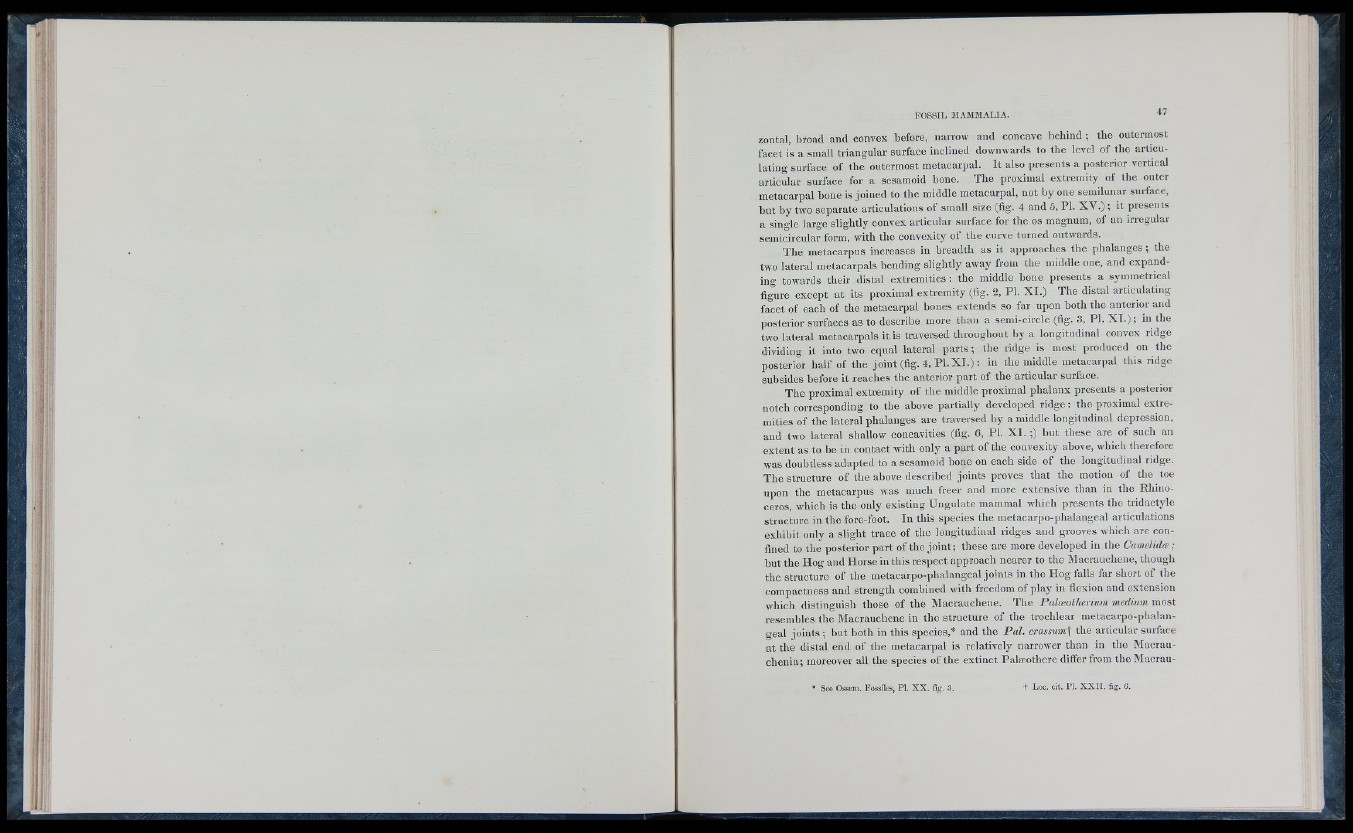
zontal, broad and convex before, narrow and concave behind ; the outermost
facet is a small triangular surface inclined downwards to the level o f the articulating
surface o f the outermost metacarpal. It also presents a posterior vertical
articular surface for a sesamoid hone. Th e proximal extremity o f the outer
metacarpal bone is joined to tlie middle metacarpal, not by one semilunar surface,
but h y two separate articulations o f small size (fig. 4 and 5, PI. X V .) ; it presents
a sing le large slightly convex articular surface for the os magnum, o f an irregular
semicircular form, with the convexity o f the curve turned outwards.
The metacarpus increases in breadth as it approaches the phalanges ; the
two lateral metacarpals bending sligh tly away fiom the middle one, and expanding
towards their distal extremities : the middle hone presents a symmetrical
figure ex c ep t at its proximal extremity (fig. 2 , P i. X I .) T he distal articulating
facet o f each of the metacarpal hones extends so far upon both the anterior and
posterior surfaces as to describe more than a semi-circle (fig. 3, PI. X I .) ; in the
two lateral metacarpals it is traversed throughout by a longitudinal convex ridge
dividing it into two equal lateral p a rts; the ridge is most produced on the
posterior h a lf o f the jo in t (fig. 4, PI. X I .) : in the middle metacarpal this ridge
subsides before it reaches the anterior part o f the articular surface.
The proximal extremity o f the middle proximal phalanx presents a posterior
notch corresponding to the above partially developed ridge : the proximal extremities
o f the lateral phalanges are traversed b y a middle longitudinal depression,
and two lateral shallow concavities (fig. 6 , PI. X I . ;) but th ese are o f such an
ex tent as to be in contact with only a part of the convexity above, whicli therefore
was doubtless adapted to a sesamoid bone on each side o f the longitudinal ridge.
The structure o f the above described joints proves that the motion o f the toe
upon the metacarpus was much freer and more ex ten siv e than in the Rhinoceros,
which is the only ex isting Ungu la te mammal which presents the tridactyle
structure in the fore-foot. In this spe cie s the metacarpo-phalangeal articulations
exliibit only a sligh t trace o f tlie longitudinal ridges and grooves which are confined
to the posterior part o f the joint ; these are more developed in the Camelidæ ;
hut the Hog and Horse in this respect approach nearer to tlie Macrauchene, though
the structure o f the metacarpo-phalangeal joints in the Hog falls far short o f the
compactness and strength combined with freedom o f play in flexion and extension
wliich distinguish those o f the Macrauchene. The Paloeotherimn medium most
resembles the Macrauchene in the structure o f the trochlear metacarpo-phalangeal
jo in ts; but both in this spe cie s,* and the P a l. crassum^ the articular surface
at tlie distal end o f the metacarpal is relatively narrower than in the Macrauchenia;
moreover all the spe cie s o f the ex tinc t Palæothere differ from the Macrau-
' See Ossem. Fossiles, PI. X X . fig. 3. t Loc. cit. PI. XXIT. fig. 6.